Briefing Paper: Evaluating Policies in Jessica's Case Study - SWK4106
VerifiedAdded on 2023/03/17
|12
|3585
|50
Report
AI Summary
This briefing paper examines the case of Jessica, a secondary school student facing multiple challenges, including poverty, hygiene issues, and lack of parental support, within the context of the Indue card program in a rural Australian community. The paper analyzes Jessica's situation, highlighting the limitations and failures of the program in addressing her specific needs and overall child welfare. It explores the program's objectives, such as improving child well-being, and assesses whether these goals are being met in Jessica's case. The analysis also considers the broader impact of the program on families and schools, including parental involvement and school attendance. The paper concludes by emphasizing the gaps in the policy's implementation and its effectiveness in providing adequate support to vulnerable children like Jessica. The paper also explores the expectations from the cashless debit card program and the impact on the children.

Briefing Paper
Briefing Paper
Name
Professor
Institution
Course
Date
Briefing Paper
Name
Professor
Institution
Course
Date
Paraphrase This Document
Need a fresh take? Get an instant paraphrase of this document with our AI Paraphraser
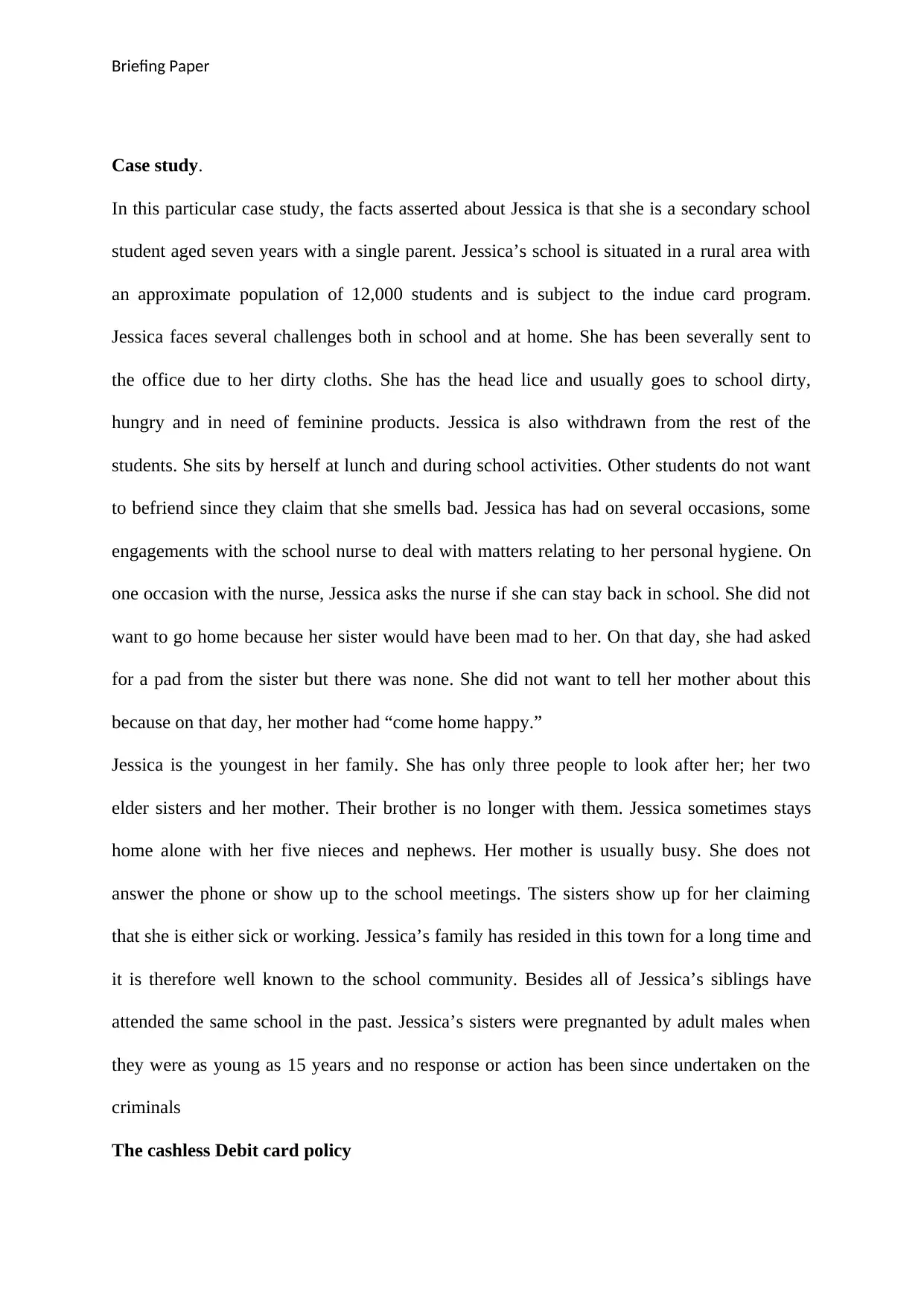
Briefing Paper
Case study.
In this particular case study, the facts asserted about Jessica is that she is a secondary school
student aged seven years with a single parent. Jessica’s school is situated in a rural area with
an approximate population of 12,000 students and is subject to the indue card program.
Jessica faces several challenges both in school and at home. She has been severally sent to
the office due to her dirty cloths. She has the head lice and usually goes to school dirty,
hungry and in need of feminine products. Jessica is also withdrawn from the rest of the
students. She sits by herself at lunch and during school activities. Other students do not want
to befriend since they claim that she smells bad. Jessica has had on several occasions, some
engagements with the school nurse to deal with matters relating to her personal hygiene. On
one occasion with the nurse, Jessica asks the nurse if she can stay back in school. She did not
want to go home because her sister would have been mad to her. On that day, she had asked
for a pad from the sister but there was none. She did not want to tell her mother about this
because on that day, her mother had “come home happy.”
Jessica is the youngest in her family. She has only three people to look after her; her two
elder sisters and her mother. Their brother is no longer with them. Jessica sometimes stays
home alone with her five nieces and nephews. Her mother is usually busy. She does not
answer the phone or show up to the school meetings. The sisters show up for her claiming
that she is either sick or working. Jessica’s family has resided in this town for a long time and
it is therefore well known to the school community. Besides all of Jessica’s siblings have
attended the same school in the past. Jessica’s sisters were pregnanted by adult males when
they were as young as 15 years and no response or action has been since undertaken on the
criminals
The cashless Debit card policy
Case study.
In this particular case study, the facts asserted about Jessica is that she is a secondary school
student aged seven years with a single parent. Jessica’s school is situated in a rural area with
an approximate population of 12,000 students and is subject to the indue card program.
Jessica faces several challenges both in school and at home. She has been severally sent to
the office due to her dirty cloths. She has the head lice and usually goes to school dirty,
hungry and in need of feminine products. Jessica is also withdrawn from the rest of the
students. She sits by herself at lunch and during school activities. Other students do not want
to befriend since they claim that she smells bad. Jessica has had on several occasions, some
engagements with the school nurse to deal with matters relating to her personal hygiene. On
one occasion with the nurse, Jessica asks the nurse if she can stay back in school. She did not
want to go home because her sister would have been mad to her. On that day, she had asked
for a pad from the sister but there was none. She did not want to tell her mother about this
because on that day, her mother had “come home happy.”
Jessica is the youngest in her family. She has only three people to look after her; her two
elder sisters and her mother. Their brother is no longer with them. Jessica sometimes stays
home alone with her five nieces and nephews. Her mother is usually busy. She does not
answer the phone or show up to the school meetings. The sisters show up for her claiming
that she is either sick or working. Jessica’s family has resided in this town for a long time and
it is therefore well known to the school community. Besides all of Jessica’s siblings have
attended the same school in the past. Jessica’s sisters were pregnanted by adult males when
they were as young as 15 years and no response or action has been since undertaken on the
criminals
The cashless Debit card policy
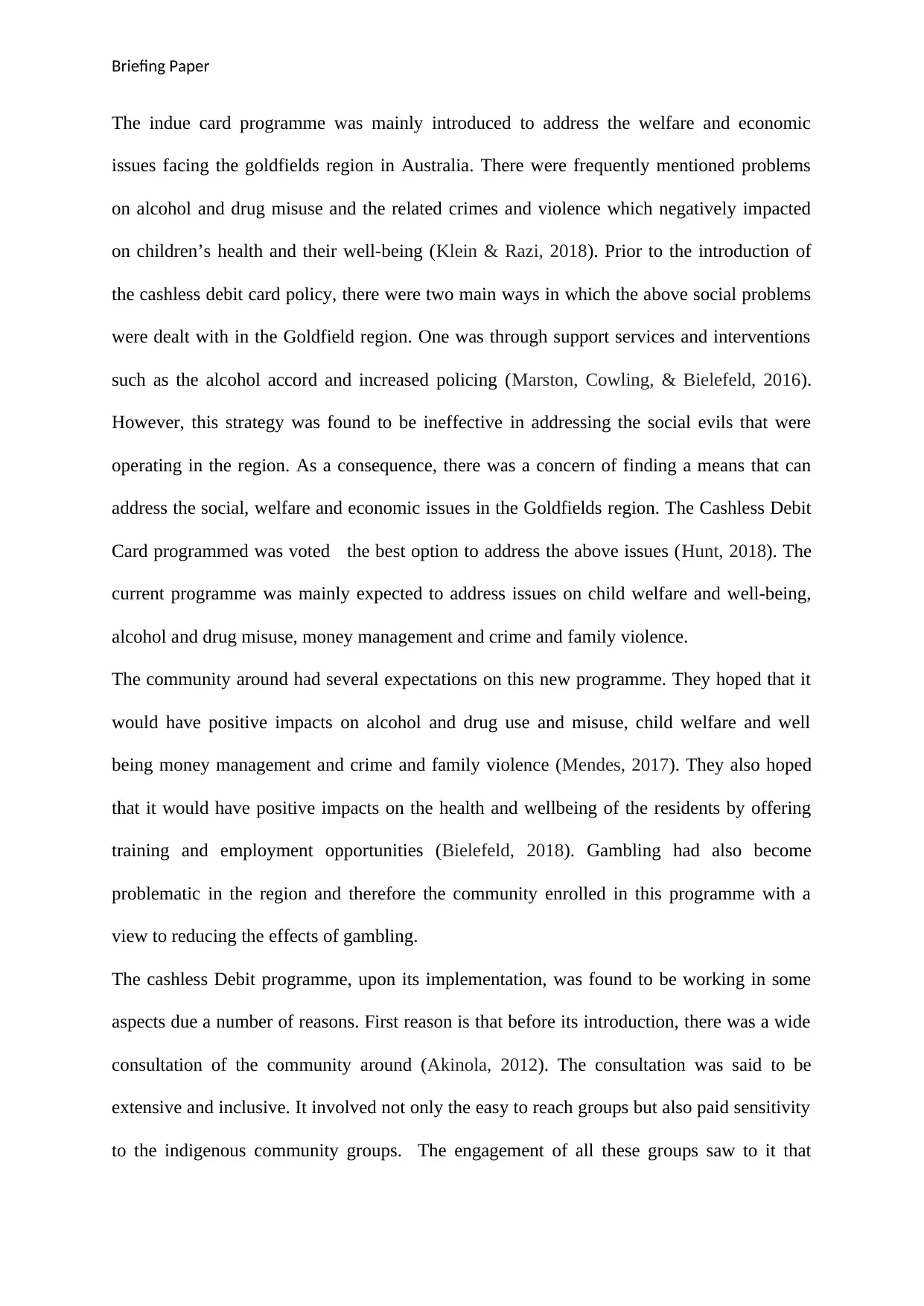
Briefing Paper
The indue card programme was mainly introduced to address the welfare and economic
issues facing the goldfields region in Australia. There were frequently mentioned problems
on alcohol and drug misuse and the related crimes and violence which negatively impacted
on children’s health and their well-being (Klein & Razi, 2018). Prior to the introduction of
the cashless debit card policy, there were two main ways in which the above social problems
were dealt with in the Goldfield region. One was through support services and interventions
such as the alcohol accord and increased policing (Marston, Cowling, & Bielefeld, 2016).
However, this strategy was found to be ineffective in addressing the social evils that were
operating in the region. As a consequence, there was a concern of finding a means that can
address the social, welfare and economic issues in the Goldfields region. The Cashless Debit
Card programmed was voted the best option to address the above issues (Hunt, 2018). The
current programme was mainly expected to address issues on child welfare and well-being,
alcohol and drug misuse, money management and crime and family violence.
The community around had several expectations on this new programme. They hoped that it
would have positive impacts on alcohol and drug use and misuse, child welfare and well
being money management and crime and family violence (Mendes, 2017). They also hoped
that it would have positive impacts on the health and wellbeing of the residents by offering
training and employment opportunities (Bielefeld, 2018). Gambling had also become
problematic in the region and therefore the community enrolled in this programme with a
view to reducing the effects of gambling.
The cashless Debit programme, upon its implementation, was found to be working in some
aspects due a number of reasons. First reason is that before its introduction, there was a wide
consultation of the community around (Akinola, 2012). The consultation was said to be
extensive and inclusive. It involved not only the easy to reach groups but also paid sensitivity
to the indigenous community groups. The engagement of all these groups saw to it that
The indue card programme was mainly introduced to address the welfare and economic
issues facing the goldfields region in Australia. There were frequently mentioned problems
on alcohol and drug misuse and the related crimes and violence which negatively impacted
on children’s health and their well-being (Klein & Razi, 2018). Prior to the introduction of
the cashless debit card policy, there were two main ways in which the above social problems
were dealt with in the Goldfield region. One was through support services and interventions
such as the alcohol accord and increased policing (Marston, Cowling, & Bielefeld, 2016).
However, this strategy was found to be ineffective in addressing the social evils that were
operating in the region. As a consequence, there was a concern of finding a means that can
address the social, welfare and economic issues in the Goldfields region. The Cashless Debit
Card programmed was voted the best option to address the above issues (Hunt, 2018). The
current programme was mainly expected to address issues on child welfare and well-being,
alcohol and drug misuse, money management and crime and family violence.
The community around had several expectations on this new programme. They hoped that it
would have positive impacts on alcohol and drug use and misuse, child welfare and well
being money management and crime and family violence (Mendes, 2017). They also hoped
that it would have positive impacts on the health and wellbeing of the residents by offering
training and employment opportunities (Bielefeld, 2018). Gambling had also become
problematic in the region and therefore the community enrolled in this programme with a
view to reducing the effects of gambling.
The cashless Debit programme, upon its implementation, was found to be working in some
aspects due a number of reasons. First reason is that before its introduction, there was a wide
consultation of the community around (Akinola, 2012). The consultation was said to be
extensive and inclusive. It involved not only the easy to reach groups but also paid sensitivity
to the indigenous community groups. The engagement of all these groups saw to it that
⊘ This is a preview!⊘
Do you want full access?
Subscribe today to unlock all pages.

Trusted by 1+ million students worldwide
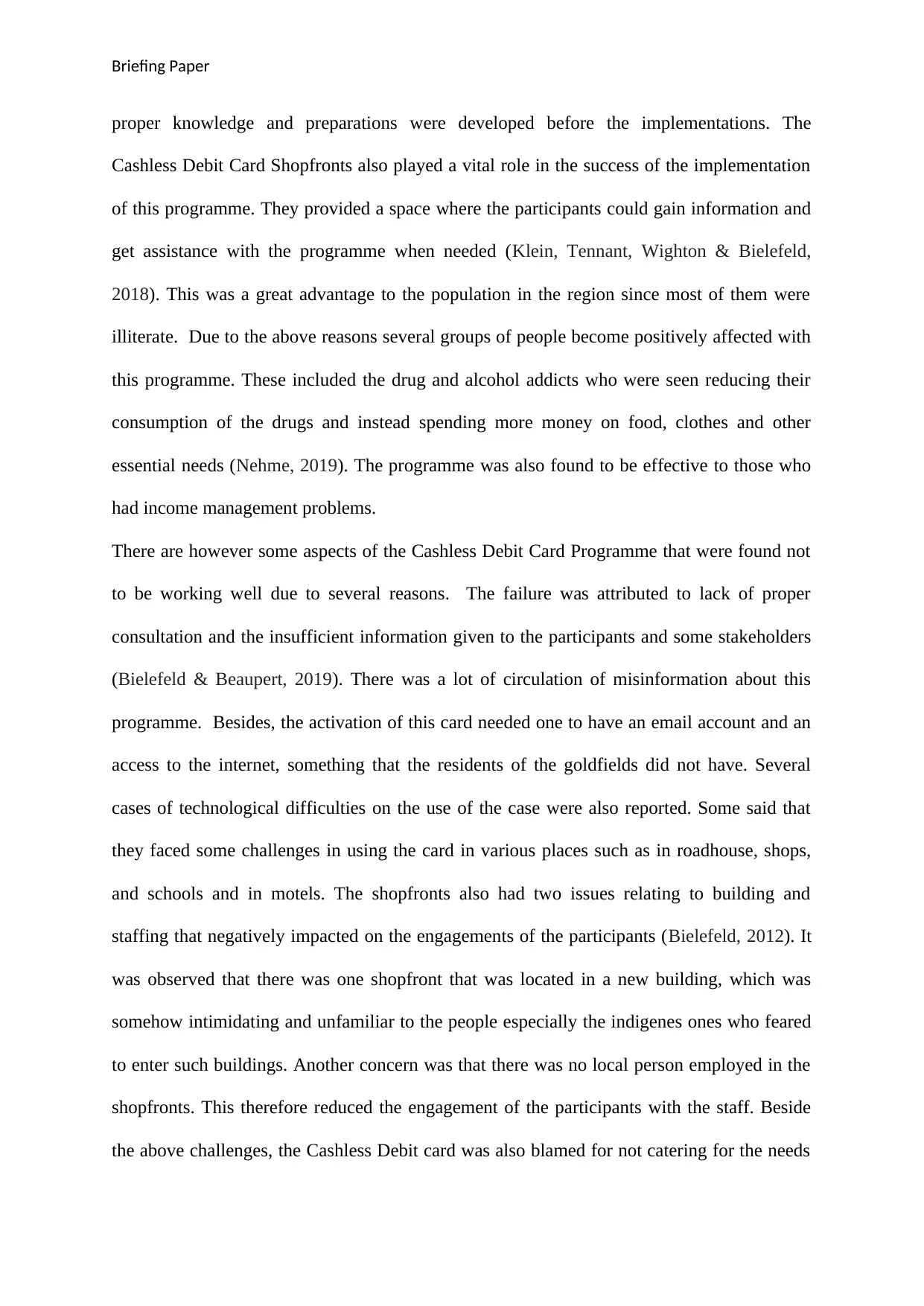
Briefing Paper
proper knowledge and preparations were developed before the implementations. The
Cashless Debit Card Shopfronts also played a vital role in the success of the implementation
of this programme. They provided a space where the participants could gain information and
get assistance with the programme when needed (Klein, Tennant, Wighton & Bielefeld,
2018). This was a great advantage to the population in the region since most of them were
illiterate. Due to the above reasons several groups of people become positively affected with
this programme. These included the drug and alcohol addicts who were seen reducing their
consumption of the drugs and instead spending more money on food, clothes and other
essential needs (Nehme, 2019). The programme was also found to be effective to those who
had income management problems.
There are however some aspects of the Cashless Debit Card Programme that were found not
to be working well due to several reasons. The failure was attributed to lack of proper
consultation and the insufficient information given to the participants and some stakeholders
(Bielefeld & Beaupert, 2019). There was a lot of circulation of misinformation about this
programme. Besides, the activation of this card needed one to have an email account and an
access to the internet, something that the residents of the goldfields did not have. Several
cases of technological difficulties on the use of the case were also reported. Some said that
they faced some challenges in using the card in various places such as in roadhouse, shops,
and schools and in motels. The shopfronts also had two issues relating to building and
staffing that negatively impacted on the engagements of the participants (Bielefeld, 2012). It
was observed that there was one shopfront that was located in a new building, which was
somehow intimidating and unfamiliar to the people especially the indigenes ones who feared
to enter such buildings. Another concern was that there was no local person employed in the
shopfronts. This therefore reduced the engagement of the participants with the staff. Beside
the above challenges, the Cashless Debit card was also blamed for not catering for the needs
proper knowledge and preparations were developed before the implementations. The
Cashless Debit Card Shopfronts also played a vital role in the success of the implementation
of this programme. They provided a space where the participants could gain information and
get assistance with the programme when needed (Klein, Tennant, Wighton & Bielefeld,
2018). This was a great advantage to the population in the region since most of them were
illiterate. Due to the above reasons several groups of people become positively affected with
this programme. These included the drug and alcohol addicts who were seen reducing their
consumption of the drugs and instead spending more money on food, clothes and other
essential needs (Nehme, 2019). The programme was also found to be effective to those who
had income management problems.
There are however some aspects of the Cashless Debit Card Programme that were found not
to be working well due to several reasons. The failure was attributed to lack of proper
consultation and the insufficient information given to the participants and some stakeholders
(Bielefeld & Beaupert, 2019). There was a lot of circulation of misinformation about this
programme. Besides, the activation of this card needed one to have an email account and an
access to the internet, something that the residents of the goldfields did not have. Several
cases of technological difficulties on the use of the case were also reported. Some said that
they faced some challenges in using the card in various places such as in roadhouse, shops,
and schools and in motels. The shopfronts also had two issues relating to building and
staffing that negatively impacted on the engagements of the participants (Bielefeld, 2012). It
was observed that there was one shopfront that was located in a new building, which was
somehow intimidating and unfamiliar to the people especially the indigenes ones who feared
to enter such buildings. Another concern was that there was no local person employed in the
shopfronts. This therefore reduced the engagement of the participants with the staff. Beside
the above challenges, the Cashless Debit card was also blamed for not catering for the needs
Paraphrase This Document
Need a fresh take? Get an instant paraphrase of this document with our AI Paraphraser
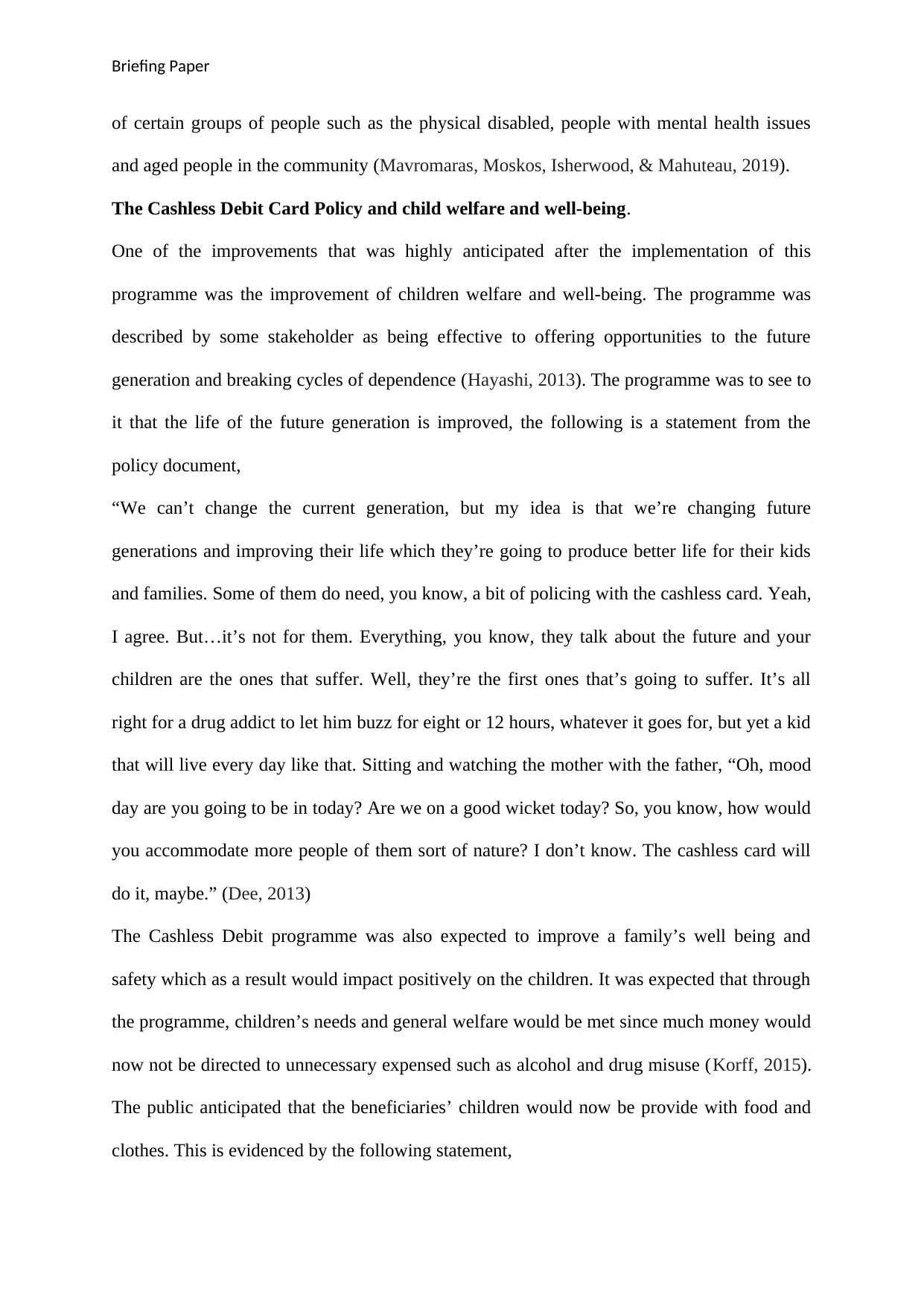
Briefing Paper
of certain groups of people such as the physical disabled, people with mental health issues
and aged people in the community (Mavromaras, Moskos, Isherwood, & Mahuteau, 2019).
The Cashless Debit Card Policy and child welfare and well-being.
One of the improvements that was highly anticipated after the implementation of this
programme was the improvement of children welfare and well-being. The programme was
described by some stakeholder as being effective to offering opportunities to the future
generation and breaking cycles of dependence (Hayashi, 2013). The programme was to see to
it that the life of the future generation is improved, the following is a statement from the
policy document,
“We can’t change the current generation, but my idea is that we’re changing future
generations and improving their life which they’re going to produce better life for their kids
and families. Some of them do need, you know, a bit of policing with the cashless card. Yeah,
I agree. But…it’s not for them. Everything, you know, they talk about the future and your
children are the ones that suffer. Well, they’re the first ones that’s going to suffer. It’s all
right for a drug addict to let him buzz for eight or 12 hours, whatever it goes for, but yet a kid
that will live every day like that. Sitting and watching the mother with the father, “Oh, mood
day are you going to be in today? Are we on a good wicket today? So, you know, how would
you accommodate more people of them sort of nature? I don’t know. The cashless card will
do it, maybe.” (Dee, 2013)
The Cashless Debit programme was also expected to improve a family’s well being and
safety which as a result would impact positively on the children. It was expected that through
the programme, children’s needs and general welfare would be met since much money would
now not be directed to unnecessary expensed such as alcohol and drug misuse (Korff, 2015).
The public anticipated that the beneficiaries’ children would now be provide with food and
clothes. This is evidenced by the following statement,
of certain groups of people such as the physical disabled, people with mental health issues
and aged people in the community (Mavromaras, Moskos, Isherwood, & Mahuteau, 2019).
The Cashless Debit Card Policy and child welfare and well-being.
One of the improvements that was highly anticipated after the implementation of this
programme was the improvement of children welfare and well-being. The programme was
described by some stakeholder as being effective to offering opportunities to the future
generation and breaking cycles of dependence (Hayashi, 2013). The programme was to see to
it that the life of the future generation is improved, the following is a statement from the
policy document,
“We can’t change the current generation, but my idea is that we’re changing future
generations and improving their life which they’re going to produce better life for their kids
and families. Some of them do need, you know, a bit of policing with the cashless card. Yeah,
I agree. But…it’s not for them. Everything, you know, they talk about the future and your
children are the ones that suffer. Well, they’re the first ones that’s going to suffer. It’s all
right for a drug addict to let him buzz for eight or 12 hours, whatever it goes for, but yet a kid
that will live every day like that. Sitting and watching the mother with the father, “Oh, mood
day are you going to be in today? Are we on a good wicket today? So, you know, how would
you accommodate more people of them sort of nature? I don’t know. The cashless card will
do it, maybe.” (Dee, 2013)
The Cashless Debit programme was also expected to improve a family’s well being and
safety which as a result would impact positively on the children. It was expected that through
the programme, children’s needs and general welfare would be met since much money would
now not be directed to unnecessary expensed such as alcohol and drug misuse (Korff, 2015).
The public anticipated that the beneficiaries’ children would now be provide with food and
clothes. This is evidenced by the following statement,
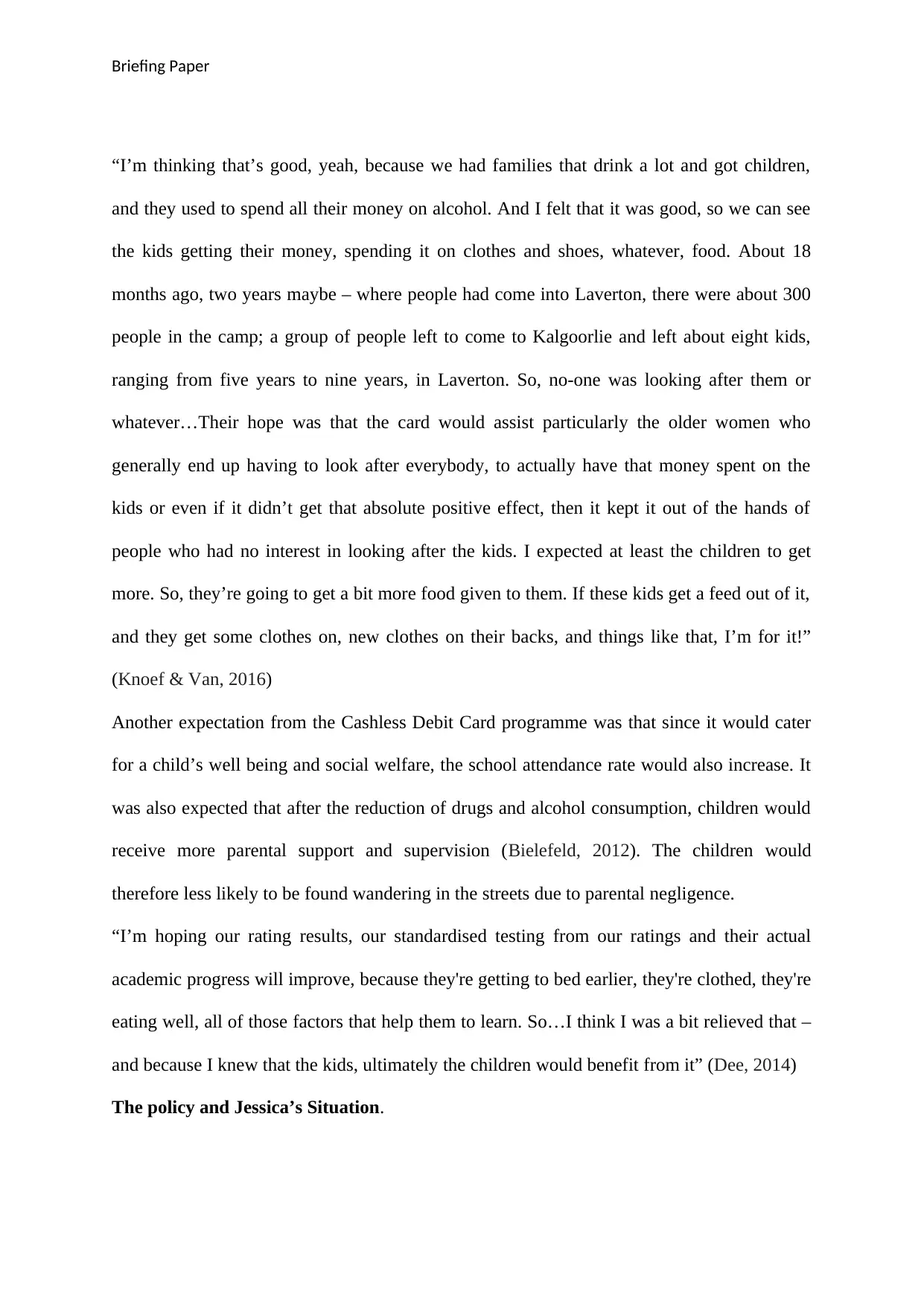
Briefing Paper
“I’m thinking that’s good, yeah, because we had families that drink a lot and got children,
and they used to spend all their money on alcohol. And I felt that it was good, so we can see
the kids getting their money, spending it on clothes and shoes, whatever, food. About 18
months ago, two years maybe – where people had come into Laverton, there were about 300
people in the camp; a group of people left to come to Kalgoorlie and left about eight kids,
ranging from five years to nine years, in Laverton. So, no-one was looking after them or
whatever…Their hope was that the card would assist particularly the older women who
generally end up having to look after everybody, to actually have that money spent on the
kids or even if it didn’t get that absolute positive effect, then it kept it out of the hands of
people who had no interest in looking after the kids. I expected at least the children to get
more. So, they’re going to get a bit more food given to them. If these kids get a feed out of it,
and they get some clothes on, new clothes on their backs, and things like that, I’m for it!”
(Knoef & Van, 2016)
Another expectation from the Cashless Debit Card programme was that since it would cater
for a child’s well being and social welfare, the school attendance rate would also increase. It
was also expected that after the reduction of drugs and alcohol consumption, children would
receive more parental support and supervision (Bielefeld, 2012). The children would
therefore less likely to be found wandering in the streets due to parental negligence.
“I’m hoping our rating results, our standardised testing from our ratings and their actual
academic progress will improve, because they're getting to bed earlier, they're clothed, they're
eating well, all of those factors that help them to learn. So…I think I was a bit relieved that –
and because I knew that the kids, ultimately the children would benefit from it” (Dee, 2014)
The policy and Jessica’s Situation.
“I’m thinking that’s good, yeah, because we had families that drink a lot and got children,
and they used to spend all their money on alcohol. And I felt that it was good, so we can see
the kids getting their money, spending it on clothes and shoes, whatever, food. About 18
months ago, two years maybe – where people had come into Laverton, there were about 300
people in the camp; a group of people left to come to Kalgoorlie and left about eight kids,
ranging from five years to nine years, in Laverton. So, no-one was looking after them or
whatever…Their hope was that the card would assist particularly the older women who
generally end up having to look after everybody, to actually have that money spent on the
kids or even if it didn’t get that absolute positive effect, then it kept it out of the hands of
people who had no interest in looking after the kids. I expected at least the children to get
more. So, they’re going to get a bit more food given to them. If these kids get a feed out of it,
and they get some clothes on, new clothes on their backs, and things like that, I’m for it!”
(Knoef & Van, 2016)
Another expectation from the Cashless Debit Card programme was that since it would cater
for a child’s well being and social welfare, the school attendance rate would also increase. It
was also expected that after the reduction of drugs and alcohol consumption, children would
receive more parental support and supervision (Bielefeld, 2012). The children would
therefore less likely to be found wandering in the streets due to parental negligence.
“I’m hoping our rating results, our standardised testing from our ratings and their actual
academic progress will improve, because they're getting to bed earlier, they're clothed, they're
eating well, all of those factors that help them to learn. So…I think I was a bit relieved that –
and because I knew that the kids, ultimately the children would benefit from it” (Dee, 2014)
The policy and Jessica’s Situation.
⊘ This is a preview!⊘
Do you want full access?
Subscribe today to unlock all pages.

Trusted by 1+ million students worldwide
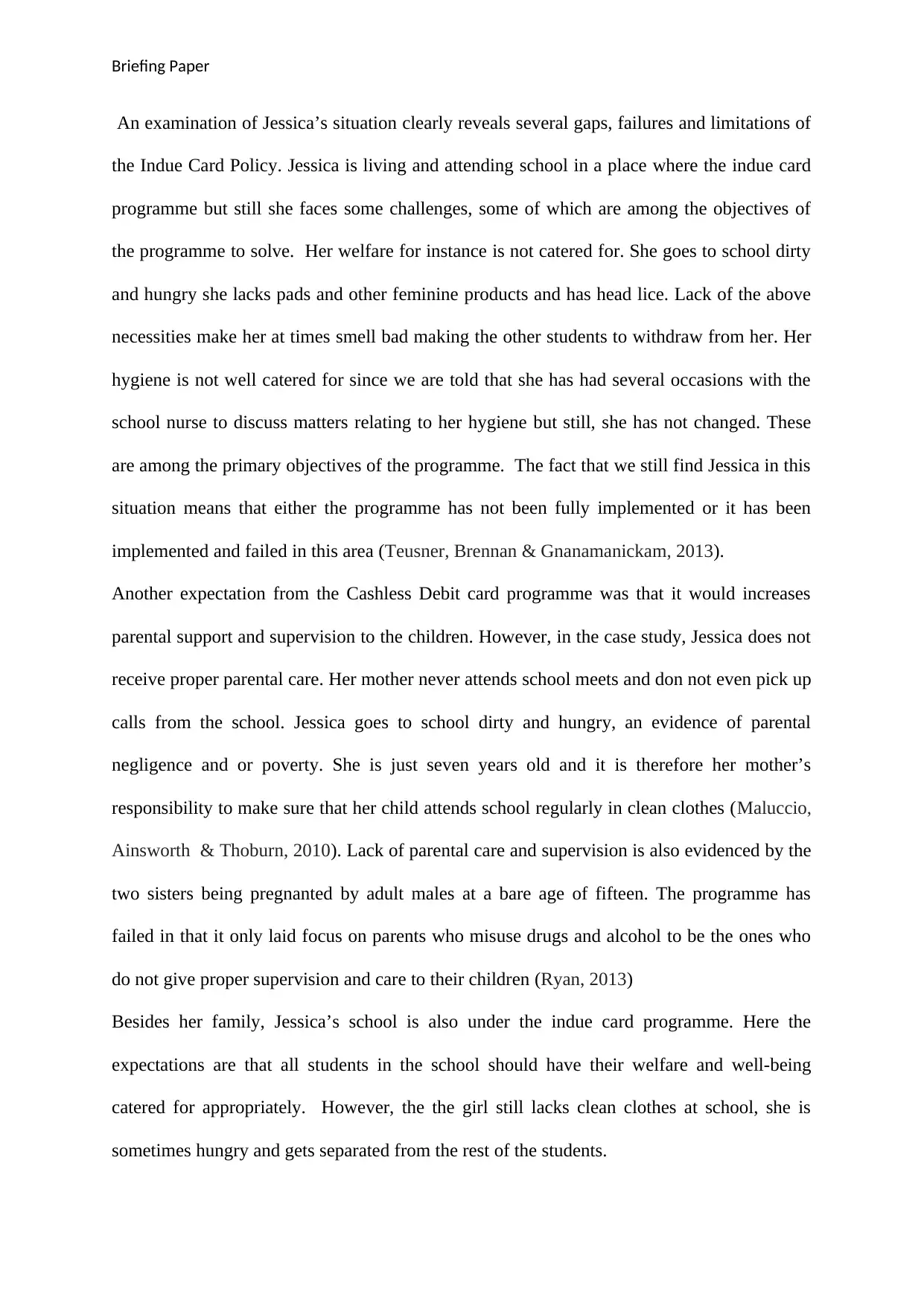
Briefing Paper
An examination of Jessica’s situation clearly reveals several gaps, failures and limitations of
the Indue Card Policy. Jessica is living and attending school in a place where the indue card
programme but still she faces some challenges, some of which are among the objectives of
the programme to solve. Her welfare for instance is not catered for. She goes to school dirty
and hungry she lacks pads and other feminine products and has head lice. Lack of the above
necessities make her at times smell bad making the other students to withdraw from her. Her
hygiene is not well catered for since we are told that she has had several occasions with the
school nurse to discuss matters relating to her hygiene but still, she has not changed. These
are among the primary objectives of the programme. The fact that we still find Jessica in this
situation means that either the programme has not been fully implemented or it has been
implemented and failed in this area (Teusner, Brennan & Gnanamanickam, 2013).
Another expectation from the Cashless Debit card programme was that it would increases
parental support and supervision to the children. However, in the case study, Jessica does not
receive proper parental care. Her mother never attends school meets and don not even pick up
calls from the school. Jessica goes to school dirty and hungry, an evidence of parental
negligence and or poverty. She is just seven years old and it is therefore her mother’s
responsibility to make sure that her child attends school regularly in clean clothes (Maluccio,
Ainsworth & Thoburn, 2010). Lack of parental care and supervision is also evidenced by the
two sisters being pregnanted by adult males at a bare age of fifteen. The programme has
failed in that it only laid focus on parents who misuse drugs and alcohol to be the ones who
do not give proper supervision and care to their children (Ryan, 2013)
Besides her family, Jessica’s school is also under the indue card programme. Here the
expectations are that all students in the school should have their welfare and well-being
catered for appropriately. However, the the girl still lacks clean clothes at school, she is
sometimes hungry and gets separated from the rest of the students.
An examination of Jessica’s situation clearly reveals several gaps, failures and limitations of
the Indue Card Policy. Jessica is living and attending school in a place where the indue card
programme but still she faces some challenges, some of which are among the objectives of
the programme to solve. Her welfare for instance is not catered for. She goes to school dirty
and hungry she lacks pads and other feminine products and has head lice. Lack of the above
necessities make her at times smell bad making the other students to withdraw from her. Her
hygiene is not well catered for since we are told that she has had several occasions with the
school nurse to discuss matters relating to her hygiene but still, she has not changed. These
are among the primary objectives of the programme. The fact that we still find Jessica in this
situation means that either the programme has not been fully implemented or it has been
implemented and failed in this area (Teusner, Brennan & Gnanamanickam, 2013).
Another expectation from the Cashless Debit card programme was that it would increases
parental support and supervision to the children. However, in the case study, Jessica does not
receive proper parental care. Her mother never attends school meets and don not even pick up
calls from the school. Jessica goes to school dirty and hungry, an evidence of parental
negligence and or poverty. She is just seven years old and it is therefore her mother’s
responsibility to make sure that her child attends school regularly in clean clothes (Maluccio,
Ainsworth & Thoburn, 2010). Lack of parental care and supervision is also evidenced by the
two sisters being pregnanted by adult males at a bare age of fifteen. The programme has
failed in that it only laid focus on parents who misuse drugs and alcohol to be the ones who
do not give proper supervision and care to their children (Ryan, 2013)
Besides her family, Jessica’s school is also under the indue card programme. Here the
expectations are that all students in the school should have their welfare and well-being
catered for appropriately. However, the the girl still lacks clean clothes at school, she is
sometimes hungry and gets separated from the rest of the students.
Paraphrase This Document
Need a fresh take? Get an instant paraphrase of this document with our AI Paraphraser
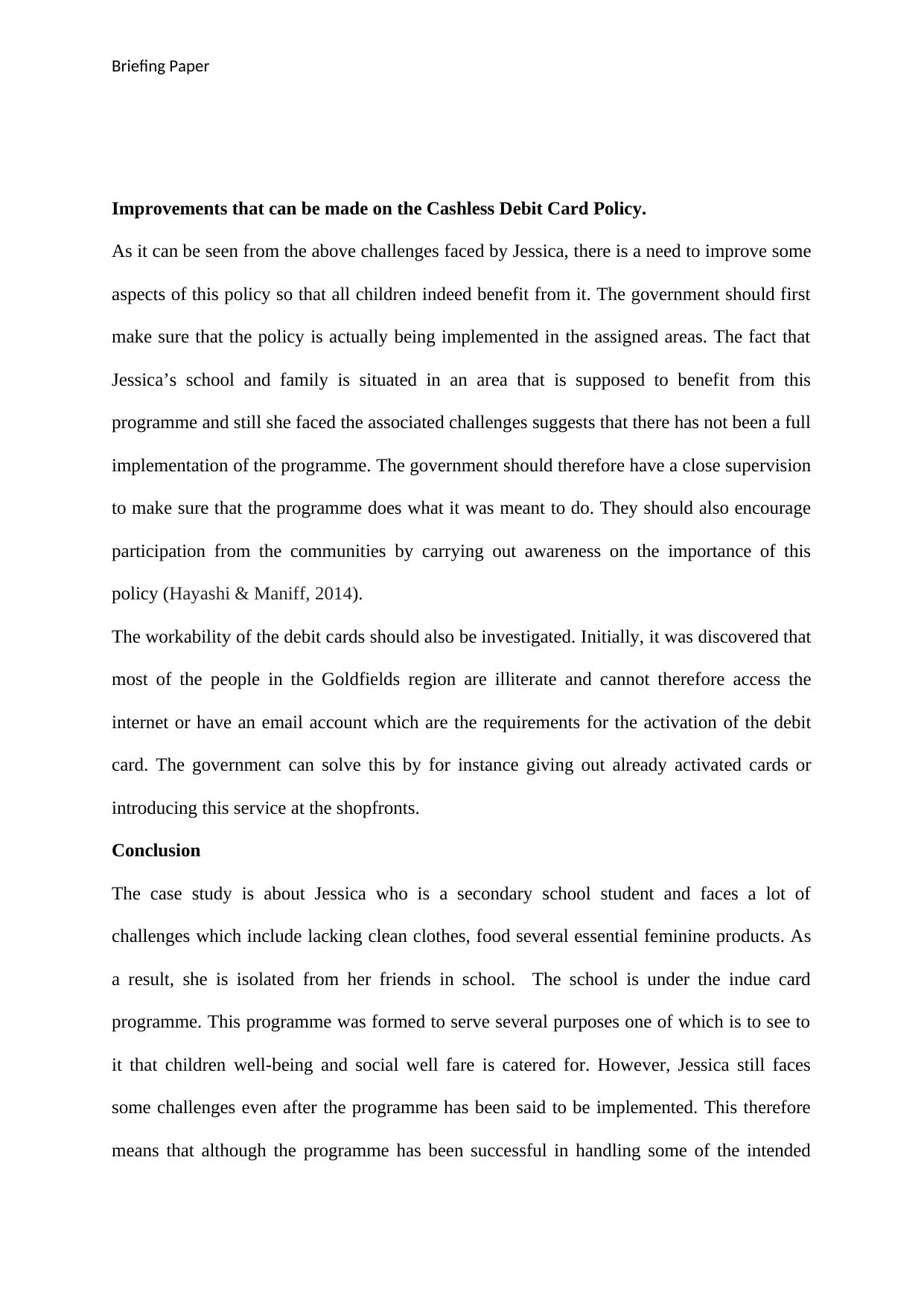
Briefing Paper
Improvements that can be made on the Cashless Debit Card Policy.
As it can be seen from the above challenges faced by Jessica, there is a need to improve some
aspects of this policy so that all children indeed benefit from it. The government should first
make sure that the policy is actually being implemented in the assigned areas. The fact that
Jessica’s school and family is situated in an area that is supposed to benefit from this
programme and still she faced the associated challenges suggests that there has not been a full
implementation of the programme. The government should therefore have a close supervision
to make sure that the programme does what it was meant to do. They should also encourage
participation from the communities by carrying out awareness on the importance of this
policy (Hayashi & Maniff, 2014).
The workability of the debit cards should also be investigated. Initially, it was discovered that
most of the people in the Goldfields region are illiterate and cannot therefore access the
internet or have an email account which are the requirements for the activation of the debit
card. The government can solve this by for instance giving out already activated cards or
introducing this service at the shopfronts.
Conclusion
The case study is about Jessica who is a secondary school student and faces a lot of
challenges which include lacking clean clothes, food several essential feminine products. As
a result, she is isolated from her friends in school. The school is under the indue card
programme. This programme was formed to serve several purposes one of which is to see to
it that children well-being and social well fare is catered for. However, Jessica still faces
some challenges even after the programme has been said to be implemented. This therefore
means that although the programme has been successful in handling some of the intended
Improvements that can be made on the Cashless Debit Card Policy.
As it can be seen from the above challenges faced by Jessica, there is a need to improve some
aspects of this policy so that all children indeed benefit from it. The government should first
make sure that the policy is actually being implemented in the assigned areas. The fact that
Jessica’s school and family is situated in an area that is supposed to benefit from this
programme and still she faced the associated challenges suggests that there has not been a full
implementation of the programme. The government should therefore have a close supervision
to make sure that the programme does what it was meant to do. They should also encourage
participation from the communities by carrying out awareness on the importance of this
policy (Hayashi & Maniff, 2014).
The workability of the debit cards should also be investigated. Initially, it was discovered that
most of the people in the Goldfields region are illiterate and cannot therefore access the
internet or have an email account which are the requirements for the activation of the debit
card. The government can solve this by for instance giving out already activated cards or
introducing this service at the shopfronts.
Conclusion
The case study is about Jessica who is a secondary school student and faces a lot of
challenges which include lacking clean clothes, food several essential feminine products. As
a result, she is isolated from her friends in school. The school is under the indue card
programme. This programme was formed to serve several purposes one of which is to see to
it that children well-being and social well fare is catered for. However, Jessica still faces
some challenges even after the programme has been said to be implemented. This therefore
means that although the programme has been successful in handling some of the intended

Briefing Paper
issues, it has not been fully implemented and the whole community has not yet taken full
participation in it. It is therefore the Governments responsibility to make sure that the whole
community is educated about the policy and that everyone is taking part in it.
issues, it has not been fully implemented and the whole community has not yet taken full
participation in it. It is therefore the Governments responsibility to make sure that the whole
community is educated about the policy and that everyone is taking part in it.
⊘ This is a preview!⊘
Do you want full access?
Subscribe today to unlock all pages.

Trusted by 1+ million students worldwide
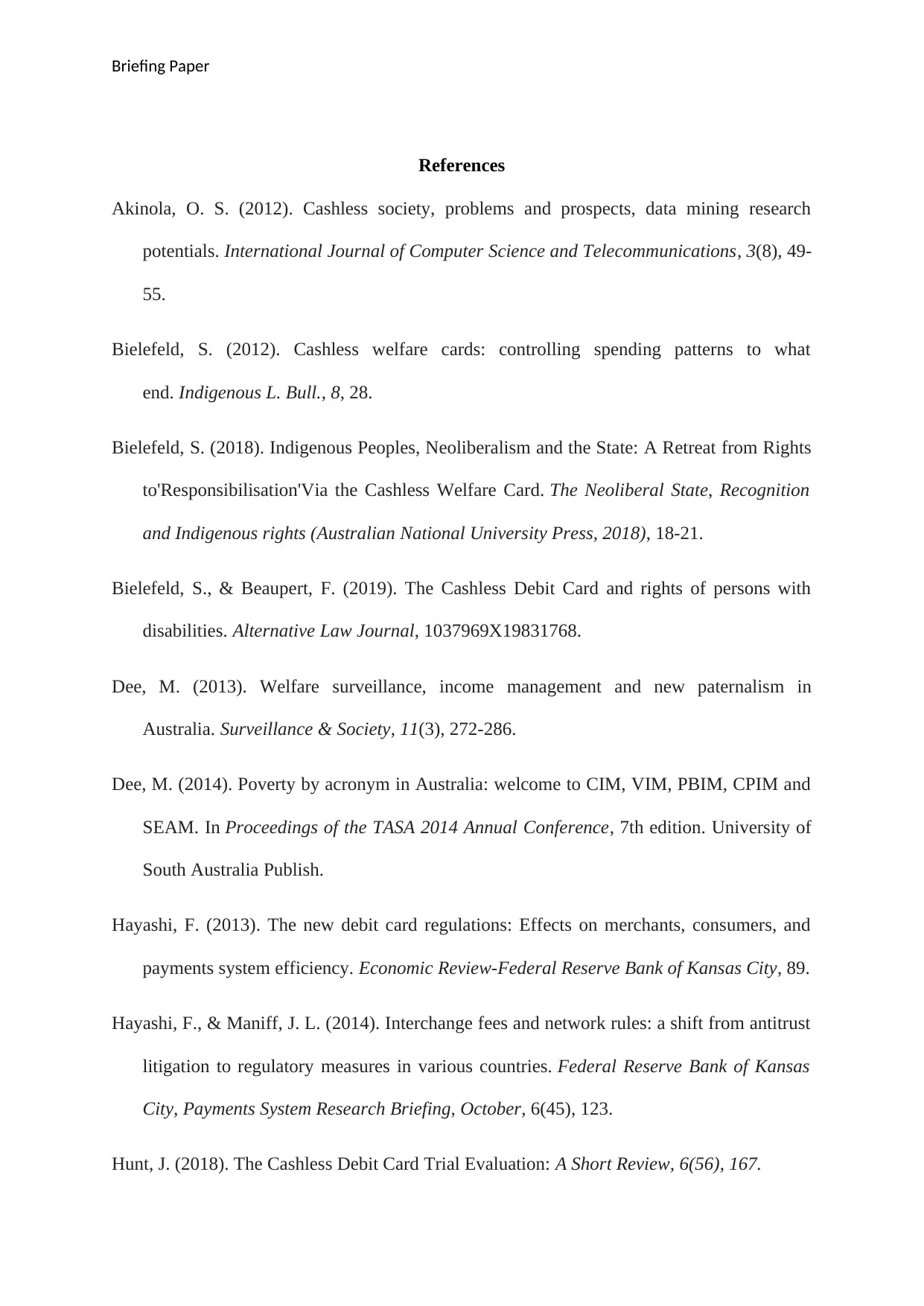
Briefing Paper
References
Akinola, O. S. (2012). Cashless society, problems and prospects, data mining research
potentials. International Journal of Computer Science and Telecommunications, 3(8), 49-
55.
Bielefeld, S. (2012). Cashless welfare cards: controlling spending patterns to what
end. Indigenous L. Bull., 8, 28.
Bielefeld, S. (2018). Indigenous Peoples, Neoliberalism and the State: A Retreat from Rights
to'Responsibilisation'Via the Cashless Welfare Card. The Neoliberal State, Recognition
and Indigenous rights (Australian National University Press, 2018), 18-21.
Bielefeld, S., & Beaupert, F. (2019). The Cashless Debit Card and rights of persons with
disabilities. Alternative Law Journal, 1037969X19831768.
Dee, M. (2013). Welfare surveillance, income management and new paternalism in
Australia. Surveillance & Society, 11(3), 272-286.
Dee, M. (2014). Poverty by acronym in Australia: welcome to CIM, VIM, PBIM, CPIM and
SEAM. In Proceedings of the TASA 2014 Annual Conference, 7th edition. University of
South Australia Publish.
Hayashi, F. (2013). The new debit card regulations: Effects on merchants, consumers, and
payments system efficiency. Economic Review-Federal Reserve Bank of Kansas City, 89.
Hayashi, F., & Maniff, J. L. (2014). Interchange fees and network rules: a shift from antitrust
litigation to regulatory measures in various countries. Federal Reserve Bank of Kansas
City, Payments System Research Briefing, October, 6(45), 123.
Hunt, J. (2018). The Cashless Debit Card Trial Evaluation: A Short Review, 6(56), 167.
References
Akinola, O. S. (2012). Cashless society, problems and prospects, data mining research
potentials. International Journal of Computer Science and Telecommunications, 3(8), 49-
55.
Bielefeld, S. (2012). Cashless welfare cards: controlling spending patterns to what
end. Indigenous L. Bull., 8, 28.
Bielefeld, S. (2018). Indigenous Peoples, Neoliberalism and the State: A Retreat from Rights
to'Responsibilisation'Via the Cashless Welfare Card. The Neoliberal State, Recognition
and Indigenous rights (Australian National University Press, 2018), 18-21.
Bielefeld, S., & Beaupert, F. (2019). The Cashless Debit Card and rights of persons with
disabilities. Alternative Law Journal, 1037969X19831768.
Dee, M. (2013). Welfare surveillance, income management and new paternalism in
Australia. Surveillance & Society, 11(3), 272-286.
Dee, M. (2014). Poverty by acronym in Australia: welcome to CIM, VIM, PBIM, CPIM and
SEAM. In Proceedings of the TASA 2014 Annual Conference, 7th edition. University of
South Australia Publish.
Hayashi, F. (2013). The new debit card regulations: Effects on merchants, consumers, and
payments system efficiency. Economic Review-Federal Reserve Bank of Kansas City, 89.
Hayashi, F., & Maniff, J. L. (2014). Interchange fees and network rules: a shift from antitrust
litigation to regulatory measures in various countries. Federal Reserve Bank of Kansas
City, Payments System Research Briefing, October, 6(45), 123.
Hunt, J. (2018). The Cashless Debit Card Trial Evaluation: A Short Review, 6(56), 167.
Paraphrase This Document
Need a fresh take? Get an instant paraphrase of this document with our AI Paraphraser
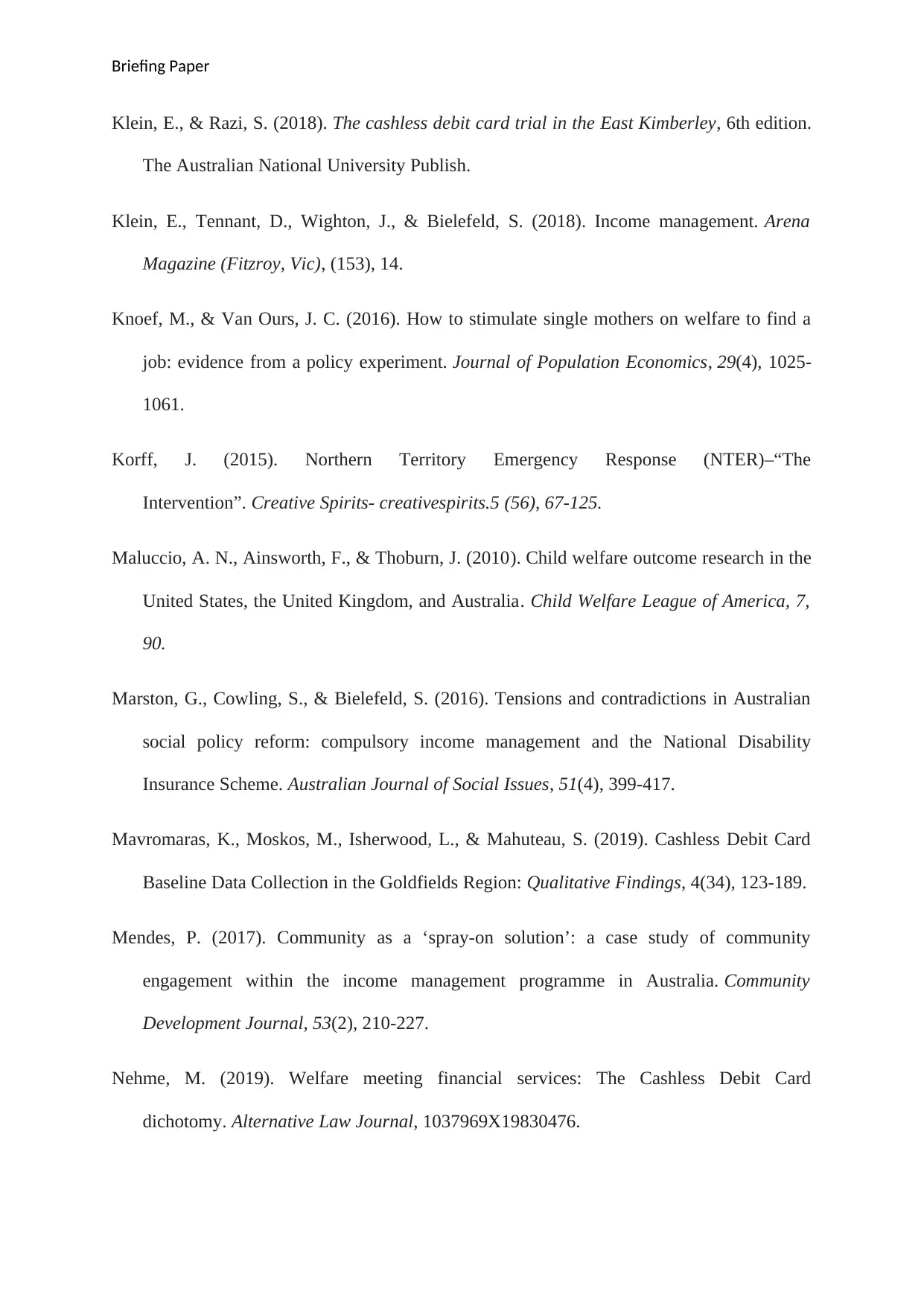
Briefing Paper
Klein, E., & Razi, S. (2018). The cashless debit card trial in the East Kimberley, 6th edition.
The Australian National University Publish.
Klein, E., Tennant, D., Wighton, J., & Bielefeld, S. (2018). Income management. Arena
Magazine (Fitzroy, Vic), (153), 14.
Knoef, M., & Van Ours, J. C. (2016). How to stimulate single mothers on welfare to find a
job: evidence from a policy experiment. Journal of Population Economics, 29(4), 1025-
1061.
Korff, J. (2015). Northern Territory Emergency Response (NTER)–“The
Intervention”. Creative Spirits- creativespirits.5 (56), 67-125.
Maluccio, A. N., Ainsworth, F., & Thoburn, J. (2010). Child welfare outcome research in the
United States, the United Kingdom, and Australia. Child Welfare League of America, 7,
90.
Marston, G., Cowling, S., & Bielefeld, S. (2016). Tensions and contradictions in Australian
social policy reform: compulsory income management and the National Disability
Insurance Scheme. Australian Journal of Social Issues, 51(4), 399-417.
Mavromaras, K., Moskos, M., Isherwood, L., & Mahuteau, S. (2019). Cashless Debit Card
Baseline Data Collection in the Goldfields Region: Qualitative Findings, 4(34), 123-189.
Mendes, P. (2017). Community as a ‘spray-on solution’: a case study of community
engagement within the income management programme in Australia. Community
Development Journal, 53(2), 210-227.
Nehme, M. (2019). Welfare meeting financial services: The Cashless Debit Card
dichotomy. Alternative Law Journal, 1037969X19830476.
Klein, E., & Razi, S. (2018). The cashless debit card trial in the East Kimberley, 6th edition.
The Australian National University Publish.
Klein, E., Tennant, D., Wighton, J., & Bielefeld, S. (2018). Income management. Arena
Magazine (Fitzroy, Vic), (153), 14.
Knoef, M., & Van Ours, J. C. (2016). How to stimulate single mothers on welfare to find a
job: evidence from a policy experiment. Journal of Population Economics, 29(4), 1025-
1061.
Korff, J. (2015). Northern Territory Emergency Response (NTER)–“The
Intervention”. Creative Spirits- creativespirits.5 (56), 67-125.
Maluccio, A. N., Ainsworth, F., & Thoburn, J. (2010). Child welfare outcome research in the
United States, the United Kingdom, and Australia. Child Welfare League of America, 7,
90.
Marston, G., Cowling, S., & Bielefeld, S. (2016). Tensions and contradictions in Australian
social policy reform: compulsory income management and the National Disability
Insurance Scheme. Australian Journal of Social Issues, 51(4), 399-417.
Mavromaras, K., Moskos, M., Isherwood, L., & Mahuteau, S. (2019). Cashless Debit Card
Baseline Data Collection in the Goldfields Region: Qualitative Findings, 4(34), 123-189.
Mendes, P. (2017). Community as a ‘spray-on solution’: a case study of community
engagement within the income management programme in Australia. Community
Development Journal, 53(2), 210-227.
Nehme, M. (2019). Welfare meeting financial services: The Cashless Debit Card
dichotomy. Alternative Law Journal, 1037969X19830476.
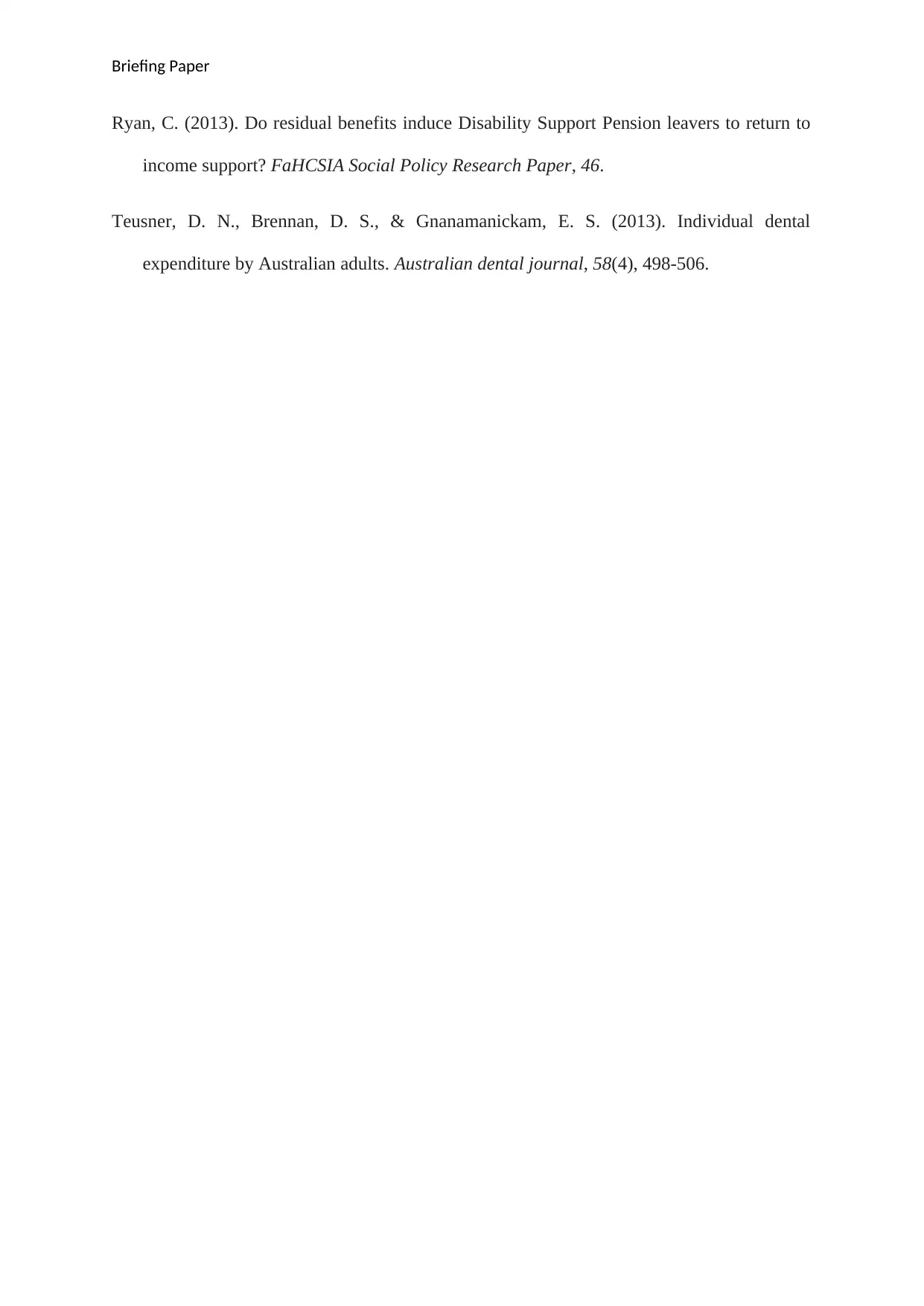
Briefing Paper
Ryan, C. (2013). Do residual benefits induce Disability Support Pension leavers to return to
income support? FaHCSIA Social Policy Research Paper, 46.
Teusner, D. N., Brennan, D. S., & Gnanamanickam, E. S. (2013). Individual dental
expenditure by Australian adults. Australian dental journal, 58(4), 498-506.
Ryan, C. (2013). Do residual benefits induce Disability Support Pension leavers to return to
income support? FaHCSIA Social Policy Research Paper, 46.
Teusner, D. N., Brennan, D. S., & Gnanamanickam, E. S. (2013). Individual dental
expenditure by Australian adults. Australian dental journal, 58(4), 498-506.
⊘ This is a preview!⊘
Do you want full access?
Subscribe today to unlock all pages.

Trusted by 1+ million students worldwide
1 out of 12
Your All-in-One AI-Powered Toolkit for Academic Success.
+13062052269
info@desklib.com
Available 24*7 on WhatsApp / Email
![[object Object]](/_next/static/media/star-bottom.7253800d.svg)
Unlock your academic potential
Copyright © 2020–2025 A2Z Services. All Rights Reserved. Developed and managed by ZUCOL.